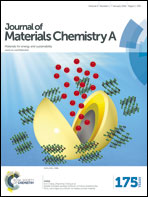Crosslinked poly(phenylene oxide)-based nanofiber composite membranes for alkaline fuel cells†
Abstract
Anion exchange membranes were fabricated from diamine-crosslinked poly(phenylene oxide) polyelectrolyte nanofibers that were functionalized with either benzyl trimethylammonium or 1,2-dimethylimidazolium groups and embedded in a reinforcing matrix of polyphenylsulfone (PPSU). Nanofibers of the polyelectrolyte precursor, brominated poly(phenylene oxide) with 0.95 CH2Br groups per mer, and PPSU were simultaneously electrospun onto a common collector and the resulting dual fiber mat was converted into a dense and defect-free anion exchange membrane by sequential soaking in a diamine crosslinker solution, exposure to chloroform vapor, and immersion in a solution of either trimethylamine or 1,2-dimethylimidazole. The degree of crosslinking and the ratio of uncharged PPSU to functionalized poly(phenylene oxide) polyelectrolyte were varied to yield composite membranes with an effective ion exchange capacity (IEC) ranging from 1.2–2.8 mmol g−1. A membrane with benzyl trimethylammonium-functionalized polyelectrolyte fibers (4.0 mmol g−1 IEC) with 15% crosslinks and 50 wt% uncharged PPSU exhibited a high hydroxide ion conductivity in water at 23 °C (66 mS cm−1), reasonable water swelling (96%), robust mechanical properties (15 MPa stress-at-break in the hydrated state), and good chemical stability in 1.0 M KOH at 60 °C. Initial hydrogen/oxygen fuel cell tests with this membrane (40 μm thick) were promising, with a peak power density of 320 mW cm−2.


 Please wait while we load your content...
Please wait while we load your content...